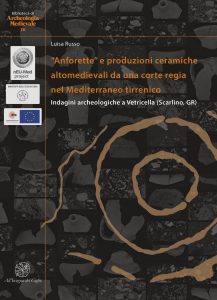Download eBook
Amphorae are a category of finds whose name refers to the most widespread transport container of the classical era, the amphora, but they differ from this above all in their small size and short-medium distribution range. Already known in the panorama of studies on medieval ceramics in common use in central Tyrrhenian Italy, the amphorae have so far been found, both through stratigraphic and surface investigations, in rather limited numbers. The Vetricella site (Scarlino, GR), however, at the center of the ERC Advanced nEU-Med project: Origins of a new economic union (7th-12th centuries): resources, landscapes and political strategies in a Mediterranean region, has returned a very considerable quantity. The volume proposes, in addition to an update of the discoveries of amphorae made in the area between southern Tuscany and upper Lazio, an in-depth study of these finds according to both a traditional and archaeometric approach. Thanks to the nEU-Med project, in fact, it was possible to carry out analyzes of provenance, absolute dating and any organic residues of the original contents. At the same time, we also tried to provide an idea of the general ceramic context in which these artefacts are inserted. The data resulting from the various aspects of the research have therefore made it possible to increase the intrinsic cognitive potential of the amphorae and to add important elements for the reconstruction of the socio-economic dynamics that characterized south-western Tuscany between the early Middle Ages and the central centuries.
Indice
Amphorae – creating new heroes of history books, di Richard Hodges
Introduzione
I. Le “anforette”: conoscenze pregresse
II. Il caso studio di Vetricella, una corte regia altomedievale nella Toscana meridionale. La storia del sito alla luce delle recenti evidenze archeologiche
III. Metodologia di studio
3.1 Premessa metodologica
3.2 Classificazione degli impasti
3.3 Analisi archeometriche
IV. Le “anforette” di Vetricella (I)
4.1 I contesti di rinvenimento
4.2 Descrizione forme e tipi
4.3 Catalogo
Tavole e Apparato fotografico
4.4 Considerazioni generali
V. Il contesto ceramico di Vetricella
5.1 La ceramica grezza (II)
5.1.1 Descrizione forme e tipi
5.1.2 Catalogo
Tavole e Apparato fotografico
5.2 La ceramica semidepurata (III)
5.2.1 Descrizione forme e tipi
5.2.2 Catalogo
Tavole e Apparato fotografico
5.3 La ceramica depurata (IV)
5.3.1 Descrizione forme e tipi
5.3.2 Catalogo
Tavole e Apparato fotografico
5.4 Breve discussione generale
5.5 Anforette, altri reperti ceramici e stratigrafia: due contesti a confronto. Acroma grezza, semidepurata e depurata dall’edificio centrale e da un sondaggio nel fossato interno
VI. Le analisi
6.1 La provenienza: analisi mineralogico-petrografiche e pXRF
6.2 La datazione: analisi alla termoluminescenza
6.3 Il contenuto: analisi dei residui organici
6.3.1 Il volume: rilievo 3D
VII. Per riassumere
VIII. Conclusioni
Bibliografia
Ringraziamenti



